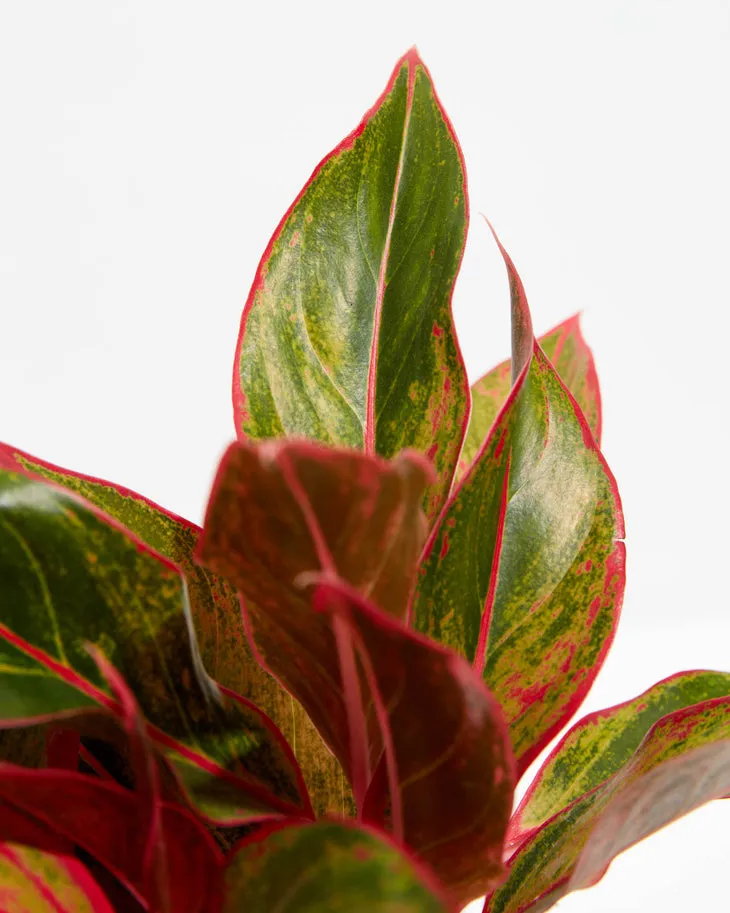Aglaonema Care
Aglaonemas are often vibrant and colorful, with strikingly patterned leaves. Because they’re so easy-going, Aglaonemas are perfectly suited for a modern living room or office, dim bedroom, or cozy study. Because of their tolerance for both moist and dry conditions, and the fact that they will thrive with low light, they are a perfect choice for less than ideal light conditions or forgetful plant owners.

How to care for your Aglaonema
- LIGHT
Your Aglaonema prefers indirect bright light. It can adapt to low light, but the growth will slow considerably. Direct morning sunlight is fine for this plant, but avoid direct afternoon sunlight which can burn the leaves. If you don’t have an ideal location for your Aglaonema, use a Grow Light. In low light, its color and variegation will not be as pronounced.
- WATER
Water your Aglaonema when 50% of the soil volume is dry. Water until liquid flows through the drainage hole at the bottom of the pot and discard any water that has accumulated in the saucer.
- HUMIDITY
This plant can survive in a low humidity environment, but it will thrive with higher humidity levels. Mist the leaves regularly using a Mister to raise the humidity, especially during the drier winter months.
- TEMPERATURE
Your Aglaonema prefers temperatures between 65–75°F. Avoid drafty areas and temperatures below 60°F in the winter.
- FOOD
Feed your Aglaonema monthly during the spring and summer months with a general-purpose houseplant fertilizer diluted to half strength such as all Purpose Fertilizer (20-20-20). No fertilizer is needed during the winter months when growth naturally slows.
- TOXICITY
Aglaonema is moderately toxic to pets and humans. Typically, ingestion will cause mouth and stomach irritation and possible vomiting.
- ADDITIONAL CARE
A common problem with Aglaonema is called ‘tipping’ when the tips of the leaves dry out and turn brown. This can be caused by a variety of issues like overwatering, too much fertilizer, etc. The most common cause is tap water, which contains salts, chlorine, and fluoride. If you do not have a filtration system, leaving the tap water in an open container overnight before watering can help remove some of the chemicals. If your Aglaonema is in need of a trim, clean up your plant using clean, sharp Plant Snips.
Common Issues for your Aglaonema
Incredibly dry soil
Be sure you’re not underwatering your Aglaonema. Keep a consistent watering schedule–water when 50-75% of the soil volume is dry.
If you accidentally let your Aglaonema’s soil dry out completely, you may see stems go limp or leaves droop and crisp up. If the soil is extremely dry all the way through the pot, a good soak is in order.
Give your plant a good soak using the bottom-soaking method:
- Fill a sink or tub with 2″-4″ of water, depending on the size of your plant.
- Set the plant in the water without the saucer to allow it to soak the water from the bottom. Let the plant sit in the water for at least 30 minutes.
- After the 30 minutes is up, feel the top of the soil to see if it has soaked up enough water. If it needs a little more time, let it sit for an additional 15-30 minutes, or water slightly from the top of the soil.
- Drain the sink and let the plant rest to allow the water to trickle from the bottom.
- Place plant back on saucer making sure there is no standing water.
Keep in mind that when the soil goes from bone-dry to saturated, it can cause stress for your Aglaonema and may cause leaves to drop. Give it some time to adjust.
Not enough humidity
Your Aglaonema will do best in a humid environment. Increase the humidity around your plant by misting it on a regular basis, using a pebble tray, or moving a humidifier nearby.
Moisture
The most common cause of yellowing leaves among Aglaonemas is improper soil moisture–in particular, overwatering. Only water your Aglaonema when 50% of the soil volume is dry. In the winter, you can allow your plant to dry out a little more between waterings.
When you do water, make sure you provide enough water so that liquid flows from the drainage hole at the bottom of the pot and into the saucer. It’s extremely important to discard any excess water in the saucer, as your Aglaonema will not respond well to “wet feet,” which causes the roots to rot and the eventual death of the plant.
Providing proper and consistent soil moisture is important in caring for an Aglaonema. Alternating between bone dry and wet soil from ill-timed waterings can create stress and cause your Aglaonema to yellow.
Your humidity level
Low humidity and dry soil cause leaves to brown on their edges, later followed by entire yellowing. Misting the leaves of your Aglaonema often will increase the humidity.
Improper Light
Generally, Aglaonemas will thrive when placed in low to bright indirect sunlight. When exposed to direct sunlight for too long, the foliage will burn and can look yellow and pale. If you don’t have an ideal location for your Aglaonema, use a Grow Light.
Pests
Weakened or stressed Aglaonemas become more susceptible to insect infestations. Sap-sucking bugs like spider mites can drain your plant of moisture. This problem quickly manifests itself by yellowing leaflets and fronds. Scale, mealybugs, and spider mites occur frequently in indoor conditions. If not killed early on, these small pests proliferate and move all along frond parts into nooks and crannies. The piercing mouths of the insects exhaust your plant and accelerate yellowing, especially if your Aglaonema is already unhealthy from poor lighting, a nutrient deficiency, or improper soil moisture.
